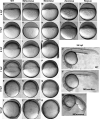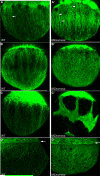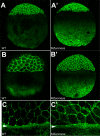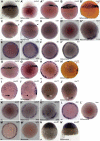Differential regulation of epiboly initiation and progression by zebrafish Eomesodermin A
- PMID: 22142964
- PMCID: PMC3259739
- DOI: 10.1016/j.ydbio.2011.10.036
Differential regulation of epiboly initiation and progression by zebrafish Eomesodermin A
Abstract
The T-box transcription factor Eomesodermin (Eomes) has been implicated in patterning and morphogenesis in frog, fish and mouse. In zebrafish, one of the two Eomes homologs, Eomesa, has been implicated in dorsal-ventral patterning, epiboly and endoderm specification in experiments employing over-expression, dominant-negative constructs and antisense morpholino oligonucleotides. Here we report for the first time the identification and characterization of an Eomesa mutant generated by TILLING. We find that Eomesa has a strictly maternal role in the initiation of epiboly, which involves doming of the yolk cell up into the overlying blastoderm. By contrast, epiboly progression is normal, demonstrating for the first time that epiboly initiation is genetically separable from progression. The yolk cell microtubules, which are required for epiboly, are defective in maternal-zygotic eomesa mutant embryos. In addition, the deep cells of the blastoderm are more tightly packed and exhibit more bleb-like protrusions than cells in control embryos. We postulate that the doming delay may be the consequence both of overly stabilized yolk cell microtubules and defects in the adhesive properties or motility of deep cells. We also show that Eomesa is required for normal expression of the endoderm markers sox32, bon and og9x; however it is not essential for endoderm formation.
Copyright © 2011 Elsevier Inc. All rights reserved.
Figures









Similar articles
-
T-box gene eomesodermin and the homeobox-containing Mix/Bix gene mtx2 regulate epiboly movements in the zebrafish.Dev Dyn. 2005 May;233(1):105-14. doi: 10.1002/dvdy.20305. Dev Dyn. 2005. PMID: 15765511 Free PMC article.
-
Maternal Eomesodermin regulates zygotic nodal gene expression for mesendoderm induction in zebrafish embryos.J Mol Cell Biol. 2014 Aug;6(4):272-85. doi: 10.1093/jmcb/mju028. Epub 2014 Jun 12. J Mol Cell Biol. 2014. PMID: 24924767
-
Global identification of Smad2 and Eomesodermin targets in zebrafish identifies a conserved transcriptional network in mesendoderm and a novel role for Eomesodermin in repression of ectodermal gene expression.BMC Biol. 2014 Oct 3;12:81. doi: 10.1186/s12915-014-0081-5. BMC Biol. 2014. PMID: 25277163 Free PMC article.
-
Mechanisms of zebrafish epiboly: A current view.Curr Top Dev Biol. 2020;136:319-341. doi: 10.1016/bs.ctdb.2019.07.001. Epub 2019 Aug 27. Curr Top Dev Biol. 2020. PMID: 31959293 Review.
-
Zebrafish epiboly: mechanics and mechanisms.Int J Dev Biol. 2010;54(8-9):1213-28. doi: 10.1387/ijdb.093028sl. Int J Dev Biol. 2010. PMID: 20712002 Review.
Cited by
-
Tris(1,3-dichloro-2-propyl) Phosphate Exposure During the Early-Blastula Stage Alters the Normal Trajectory of Zebrafish Embryogenesis.Environ Sci Technol. 2018 Sep 18;52(18):10820-10828. doi: 10.1021/acs.est.8b03730. Epub 2018 Sep 10. Environ Sci Technol. 2018. PMID: 30157643 Free PMC article.
-
Maternal Factors and Nodal Autoregulation Orchestrate Nodal Gene Expression for Embryonic Mesendoderm Induction in the Zebrafish.Front Cell Dev Biol. 2022 May 26;10:887987. doi: 10.3389/fcell.2022.887987. eCollection 2022. Front Cell Dev Biol. 2022. PMID: 35693948 Free PMC article.
-
Nxhl Controls Angiogenesis by Targeting VE-PTP Through Interaction With Nucleolin.Front Cell Dev Biol. 2021 Oct 11;9:728821. doi: 10.3389/fcell.2021.728821. eCollection 2021. Front Cell Dev Biol. 2021. PMID: 34733844 Free PMC article.
-
In Vivo Regulation of the Zebrafish Endoderm Progenitor Niche by T-Box Transcription Factors.Cell Rep. 2017 Jun 27;19(13):2782-2795. doi: 10.1016/j.celrep.2017.06.011. Cell Rep. 2017. PMID: 28658625 Free PMC article.
-
Eomes function is conserved between zebrafish and mouse and controls left-right organiser progenitor gene expression via interlocking feedforward loops.Front Cell Dev Biol. 2022 Aug 25;10:982477. doi: 10.3389/fcell.2022.982477. eCollection 2022. Front Cell Dev Biol. 2022. PMID: 36133924 Free PMC article.
References
-
- Alexander J, Rothenberg M, Henry GL, Stainier DY. casanova plays an early and essential role in endoderm formation in zebrafish. Dev. Biol. 1999;215:343–357. - PubMed
-
- Alexander J, Stainier DY. A molecular pathway leading to endoderm formation in zebrafish. Curr. Biol. 1999;9:1147–1157. - PubMed
-
- Babb SG, Marrs JA. E-cadherin regulates cell movements and tissue formation in early zebrafish embryos. Dev. Dyn. 2004;230:263–277. - PubMed
Publication types
MeSH terms
Substances
Grants and funding
LinkOut - more resources
Full Text Sources
Molecular Biology Databases

